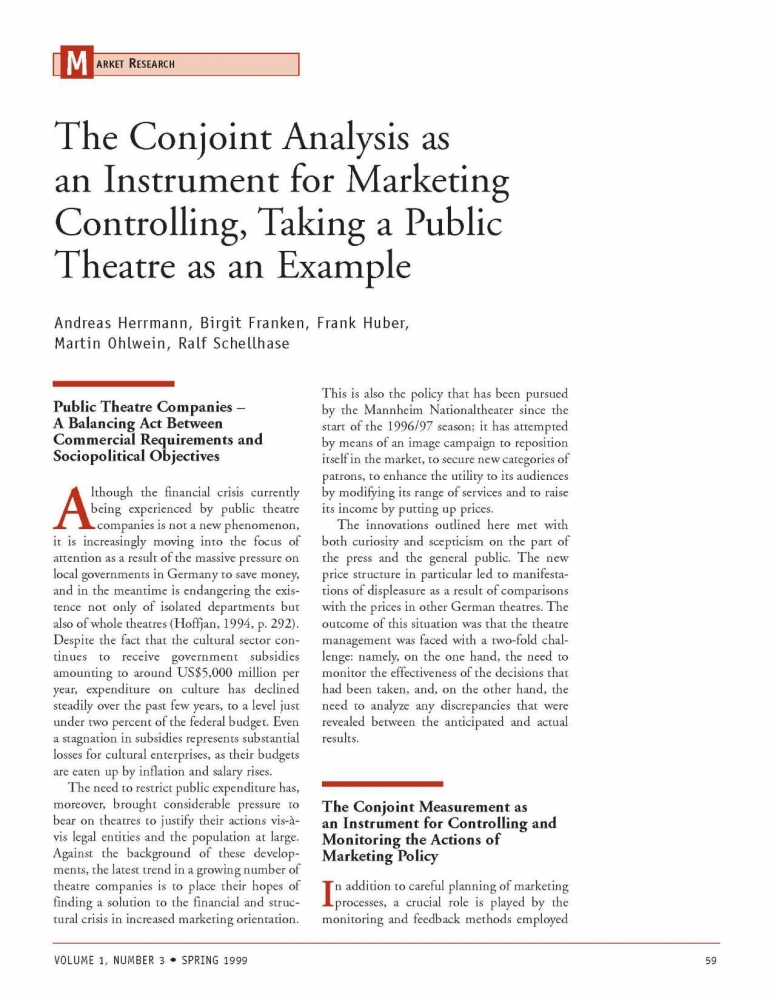The Conjoint Analysis as an Instrument for Marketing Controlling, Taking a Public Theatre as an Example
Produit: Article
21,00 $ CA
A. Herrmann, B. Franken, F. Huber, M. Ohlwein, R. Schellhase
Andreas Herrmann is professor of management, University of Mainz, Germany, and a member of the Advisory Board, CTcon, Management Consulting, Vallendar Germany. He has published nearly a hundred articles in national and international marketing and management journals, in addition to publishing five books. His main research topics are product and price policy, service marketing, marketing modeling and behavioural decision theory.
Birgit Franken is a former student at the University of Mannheim, Germany. She currently works as a product manager for a major German food brand.
Frank Huber is a Ph.D. student in marketing at the University of Mannheim, Germany. He has published about fifty articles in national and international marketing and management journals. His main research topics are product and communication policy, non-profit marketing, causal modeling and behavioural decision theory.
Martin Ohlwein is a Ph.D. student in marketing at the University of Mannheim, Germany. He has published about twenty articles in national and international marketing and management journals. His main research topics are product policy, causal modeling, brand management, customer satisfaction and non-profit marketing.
Ralf Schellhase is a Ph.D. student in marketing at the University of Mannheim, Germany. He has published about twenty articles in national and international marketing and management journals. His main research topics are product policy, city transportation marketing, customer satisfaction and non-profit marketing.
ABSTRACT
A new marketing concept was introduced by the Mannheim Nationaltheater at the start of the 1996/97 season. The new price structure in particular was the object of considerable public criticism. An empirical study attempts to determine whether theatre patrons derive greater utility from the new concept or from that in effect during the previous season. It is possible to demonstrate, with the aid of a conjoint analysis, that the public discussion regarding the measures introduced by the theatre management represents an inadequate reflection of patrons’ preferences. The suitability of the conjoint analysis, which in the past has been employed primarily in connection with the design of new products and services, as an instrument for marketing controlling is demonstrated convincingly.
KEYWORDS
Conjoint analysis, marketing controlling, public theatre, customer satisfaction
RÉSUMÉ
Le Mannheim Nationaltheater a utilisé une démarche marketing inédite pour la saison 1996-1997; la nouvelle structure tarifaire, en particulier, a fait l’objet de nombreuses critiques de la part de la population. Une étude empirique tente de déterminer si le public du théâtre considère retirer plus d’avantages de la nouvelle formule que du concept appliqué la saison précédente. Il est possible de prouver, à l’aide d’une analyse conjointe, que le débat public sur les mesures introduites par la direction du théâtre ne reflète pas véritablement les préférences des consommateurs. L’article démontre de manière probante la pertinence de l’analyse conjointe, principalement employée jusqu’à présent dans le contexte de la conception de nouveaux produits et services, comme moyen de contrôle d’un plan marketing.
MOTS CLÉS
Analyse conjointe, contrôle d’un plan marketing, théâtre subventionné, satisfaction de la clientèle
RESUMEN
A inicios de la temporada de 1996-1997, el Mannheim Nationaltheater introdujo un concepto novedoso de comercialización, cuya nueva estructura de precios suscitó acerbas críticas del público. En este artículo, se exponen los resultados de un estudio empírico elaborado con el propósito de determinar cuál de los dos conceptos, el nuevo o el vigente durante las temporadas anteriores, es de mayor utilidad para el público del teatro. Mediante un análisis conjunto, es posible demostrar que las preferencias de los espectadores estuvieron mal reflejadas en el debate público que tuvo lugar en torno a las medidas introducidas por la dirección del teatro. Se demuestra de manera convincente que el análisis conjunto, método que en el pasado se había utilizado principalmente en relación con la concepción de nuevos productos y servicios, es idóneo igualmente para comprobar de la eficacia de la comercialización.
PALABRAS CLAVE
Análisis conjunto, comprobación de la eficacia de la comercialización, público teatral, satisfacción de la clientela
